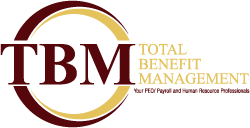- Total Benefit Management

We Can All Agree These Things Make Us Miserable at Work
December 5, 2017
Managers Who Create Growth Opportunities See Greater Employee Engagement
December 11, 2017At TBM Payroll, we are well aware that having a good company culture is important. This article comes from Entrepreneur.
6 Steps for Creating a Strong Company Culture
Building a strong culture within a team is at the core of business success. You want a culture that recognizes and embraces shared values, attitudes, standards, and beliefs that characterize the goals of the organization. And it’s a good idea to make sure it suits the best people who work at the company while making a positive impression on customers and anyone else associated with the business.
Establishing a culture you believe in means having a clear and consistent vision and knowing how you’d like everyone, inside and outside, to view the company. Many old-school CEOs and leaders were often “business operations first and people second.” But it’s the people that make a business successful. The greater inclusion of people in the operation of the business had led to far more significant contributions by employees, which spill over to more appreciation from customers. So unless you are alone with nothing by technology, your business is built around people producing products and providing services for other people.
It’s a good idea to start by sitting down with your board of directors or co-founders to write down what your core values are and how you want to weave them into the DNA of your team. It’s important that the founders uphold the culture from the very beginning. To do so, the culture has to be more than just a shared vision. If you have a vision without a strategy, it will never be more than a vision.
Here are some things I believe to be the cornerstones of a solid business culture.
1. Transparency.
At my company, we go over all the key metrics of the business with the entire company. The goal is for all employees to feel they know the thinking, responsibilities, and strategy at various levels of the company and can share ideas and feedback no matter who they are.
Another thing we do to help more transparency into the organization is what we call a TGIF. Our TGIF calls take place every other Friday and are all-hands calls. Everyone in the company can participate and ask questions. Since people often feel intimidated or uncomfortable in an any-question-welcome situation, we built a private forum on the Intergate server where employees can ask anonymous questions.
2. Time to disconnect.
We all need to hit the reset button once in a while – people can’t come in early and leave late every single day without getting burnt out at some level. While you want employees to have a work-hard founder’s mentality, you need to recognize the work-life integration that exists and how significant it is to make sure you have personally fulfilled, clear-thinking people. It’s important to understand that sometimes life will get in the way of business and everyone should be allowed to take care of pressing personal matters.
3. Empowerment and sense of freedom.
You empower people by not micromanaging, erring on the side of giving people general guidelines rather than explicit, detailed directions. Informed employees are more involved and empowered in a company. And the more freedom people have to take on tasks, manage them, find solutions, and execute them, the more they feel connected to and woven into the company’s culture.
4. Physical space.
If you haven’t watched Susan Cane’s TED Talk on introverts, I highly recommend it. She opened my mind to the idea that American businesses are built for extroverts, down to the floor plans of our office spaces. Although open spaces are great for some, other people need to be able to close the door to be at their most productive. It’s important to consider the comfort level of your employees before you decide how to lay out space or what type of office space to lease.
5. Talking to customers and employees.
At different points in a company’s maturation process, you’re almost guaranteed to go through weeks or even months where you feel lost. When you haven’t nailed a product market fit or you’re having challenges relating to your product or corporate vision, the natural tendency is to turn your attention to where you or your team went wrong. Another way to try to solve these problems is by talking to your customers.
“I go out to talk to customers to understand what works and what doesn’t work in the product,” says David Tomizuka, CFO at Integrate. “It [also] helps you refine your approach and know how you’re going to market it. And probably the most important thing is it fires you up. You get a lot of enthusiasm from being out there with customers and talking to people about your product.”
It’s also important to touch base with your employees. “As an executive, it’s easy to get wrapped up in the minutia and the day-to-day operations that you’re not out on the front lines as a leader,” Tomizuka adds. “So many leaders I know never go out and talk to their employees without an agenda. I used to schedule time just to walk the halls and get a pulse on how the culture is doing, how the employees are doing, and build and develop relationships. Making personal connections makes such a difference.”
6. Your organizational design.
Simply put, organizational design is the processes, structure, and hierarchy you put into place that allow you to put your culture into practice. It’s “how you do things.” This will include your communication, company policies, team building, performance indicators, performance evaluations, division of responsibilities, and even how your schedule, and run meetings. For example, do you have a weekly meeting at the same time and in the same place, or do you hold meetings only when there’s something worthy of discussing at a meeting? Are meetings for all employees, division heads, or certain team members? Do you always meet in conference rooms, in a specific area of the office, or by conference calls, or does the setting change?
If designed well, everyone in the business can do his or her job more effectively. Your business culture will significantly be enhanced if the organizational design you put into place clarifies authority, responsibility, and accountability.
To view the original article, click here.

